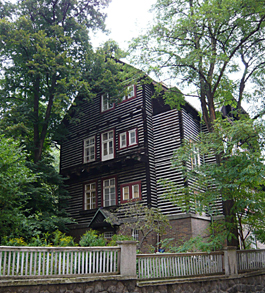
Petition against the construction of the timber cottage was signed by over 500 people
 |
According to the petition authors, 36 trees will be cut down for the construction, and traffic in the area will increase, despite access to the street being possible only through a passage in Bělehradská Street. "The plan is in conflict with the valid zoning plan, which designates this area as significant greenery," stated Eva Vavroušková (SZ), a member of the environmental commission of the city district, in a press release.
The investor plans to build a structure with 35 apartments and 42 garages in two underground levels. A glass triangular prism is to rise above the level of the surrounding terrain, while the rest of the building is to consist of a terraced structure adjacent to a retaining wall. "As a concession to the city district, the investor offers the cottage for community use. However, this is merely a cover for the fact that the villa, as such, has no real use in the project, and its demolition is prevented only by heritage protection," warned Jan Hruška, chairman of the SZ parliamentary club.
The city district council was supposed to discuss the project already in mid-October. According to the spokesperson of the city district, Kateřina Veselá, the investor will present the proposal at the upcoming meeting on November 9, as he is currently abroad.
The monumentally protected wooden villa has three residential floors with approximately 20 rooms and a technical basement. During World War II, it was used as accommodation for the Hitler Youth, and after the war, it was acquired by Charles University, which used it as a dormitory for prominent students from Africa and Arabia. In the 1980s, it was adapted for the workplace of the Prognostics Institute of the Czech Academy of Sciences, and after the revolution, part of the University of Economics. It is now in the hands of a private owner after restitution.
The English translation is powered by AI tool. Switch to Czech to view the original text source.
0 comments
add comment










